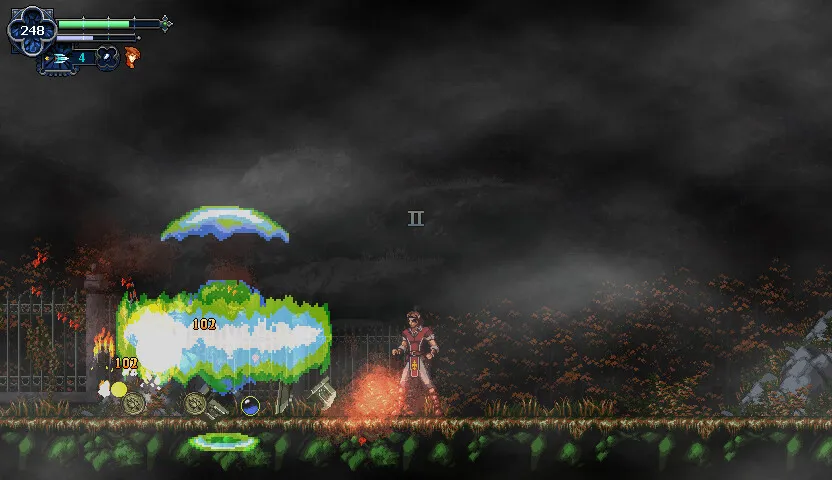In the fog-draped lands of 18th-century France, a monstrous entity terrorizes the countryside. This is the Beast of Gévaudan, a creature of folklore given new life in Chronicles of the Wolf. You are Mateo Lombardo, the sole remaining apprentice of the Rose Cross Order, a clandestine group devoted to fighting such evils.
His mission is to hunt this beast. Yet, this French legend is not told in its native tongue. Instead, it is filtered through a distinctly Japanese lens, adopting the form of a 2D action game where exploration and combat follow a rigid, classic structure.
The result is a curious dialogue between European folklore and Eastern game design philosophy, a project that seeks to house a French soul within an imported Japanese body.
A Tale of Two Gothics
The game’s presentation is a fascinating fusion of cultural aesthetics. The narrative’s foundation is purely French, rooted in the history of Gévaudan. The visuals, however, speak a different language.
The art style is a deliberate throwback to the 8-bit and 16-bit eras of Japanese consoles, rendering French forests and towns in crisp, sharp pixel art. This choice extends to the soundscape; the energetic, spooky music feels less like a cinematic score and more like a high-quality accompaniment to a classic arcade adventure.
The voice acting reinforces this, with a theatrical, “hammy” delivery that recalls the dubbed anime of the 1990s. This makes the silence of the protagonist, Mateo, all the more pronounced. He is a blank slate, a common trope in Japanese role-playing games, which creates a strange distance in a story that seems to call for a more defined Western hero.
The Ritual of Combat
The mechanics of fighting in Chronicles of the Wolf are a direct import of Japanese design principles. Mateo’s combat style is methodical. He attacks with a primary weapon, from daggers to rifles, and uses a separate sub-weapon by pressing up while attacking.
This system demands a deliberate approach from the player. A unique feature is the “ghost allies” system, where equippable spirits grant magical effects like healing or power boosts, their use limited by a resource meter. The entire combat loop feels like a ritual, prioritizing pattern recognition and tactical resource management over improvisation.
Enemy encounters operate on these terms, with clear but sometimes stiff hit detection. The player’s own weapon swings are forgivingly large, making the combat accessible. The boss battles are definite high points, presenting diverse and challenging foes that test one’s mastery of this specific, structured form of engagement.
Mapping Tradition Onto Territory
The game’s world is a large, interconnected map that unfolds as Mateo gains new abilities like a double jump or an air dash. This structure, a cornerstone of its Japanese-inspired genre, turns exploration into an act of discovery. Finding a new skill to bypass a previous obstacle provides a steady sense of progress.
The game’s adherence to tradition, however, creates friction. The map is a bare-bones affair, lacking modern conveniences like custom markers or icons for shops. This design choice forces the player to rely on memory, a demand that feels both archaic and intentional.
Navigation becomes a challenge defined by this minimalism. Vague directions can lead to aimless wandering, made more difficult by enemies that respawn upon re-entering a screen and brutally punishing instant-death traps. This unforgiving design is a relic from a different era of game development.
Lost in Translation?
Technical quirks cement the game’s identity as a product of a past age. A noticeable delay when opening the pause menu constantly interrupts the game’s flow, a jarring pause during difficult fights.
The design itself reinforces this with its infrequent save points and the inability to quickly switch between weapon types without entering a menu. Chronicles of the Wolf is a dedicated homage to a classic style of game.
It is an experience for players who understand and appreciate that specific design language, one that prioritizes a particular kind of challenge over modern accessibility. It is a study in how a European story can be retold through a foreign structural framework.
The Review
Chronicles of the Wolf
Chronicles of the Wolf is a compelling cultural experiment, dressing a French folktale in the rigid mechanics of a classic Japanese action game. While its devotion to a bygone era creates moments of aesthetic and combat satisfaction, its stubborn refusal to adopt modern conveniences results in a frustrating experience. The game successfully evokes nostalgia but struggles to find a clear identity between its European story and its Eastern-inspired design, making it a curious artifact best appreciated by genre purists.
PROS
- Strong retro aesthetic and an energetic soundtrack.
- Engaging combat system with challenging boss encounters.
- A unique narrative premise based on French folklore.
CONS
- Outdated design, lacking modern quality-of-life features.
- Frustrating navigation due to a bare-bones map and punishing traps.
- Noticeable menu lag that disrupts the gameplay flow.
